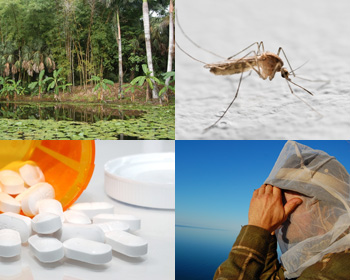A Publication of the
Applied Math and Science Education Repository

The AMSER Science Reader Monthly aims to provide educators with a useful package of information about a particular topic related to applied math and science by combining freely available articles from popular journals with curriculum, learning objects, and web sites from the AMSER portal. The AMSER Science Reader Monthly is free to use in the classroom and educators are encouraged to contact AMSER with suggestions for upcoming issues or comments and concerns at [email protected].
This month's AMSER Science Reader Monthly topic is the prevention of tropical disease and the use of forensic science.
The Fatal Consequences of Counterfeit Drugs
Article by Andrew Marshall from Smithsonian Magazine
Synopsis and resource annotations by Max Grinnell

Although it is extremely infectious, malaria is a disease that is relatively easy to cure. Easy, that is, if the anti-malaria drugs received are the real thing. But what if the cure is a complete counterfeit? Andrew Marshall, in an article from the October 2009 issue of Smithsonian Magazine , recently set off on a mission to Southeast Asia to investigate what scientists, government officials, and others are doing to combat the growing problem of counterfeit anti-malaria drugs.
One of the people fighting back against the trade and manufacture of these counterfeit anti-malaria drugs is forensic scientist and government official Ouk Vichea, who works out of an office in the Cambodian city of Battambang. Part of Vichea's work involves performing tests on small packs of medicine which claim to be artesunate, which is a powerful compound used to treat malaria. Vichea and his counterparts throughout Southeast Asia face an uphill battle, as a recent research study reported that the volume of fake pills has risen steadily.
Many opt to save money by buying the cheapest antimalarial drugs they can find, and as a result, it is more likely that they will receive some type of bogus medicine, like flour. It is hard to gauge the extent of the problem precisely, but the World Health Organization (WHO) estimates that up to 20 percent of the one million malaria deaths each year can be attributed to counterfeit drugs. As the problem becomes more widespread, new methods to combat the counterfeiters have been introduced. Drug companies have attempted to authenticate their medication by adding batch numbers and holograms to their packaging. But counterfeiters are quick to catch on, and now the bogus medications can be found with imitation holograms. In 2005, public health officials, researchers, and the World Health Organization (WHO) agreed to join forces with the International Criminal Police Organization (Interpol). This project, called the Jupiter Operation, draws on experts from a wide variety of fields to try and gather enough evidence to put the counterfeiters behind bars. Using chemical, mineralogical, biological, and packaging analysis testing, "a picture of where many of these counterfeits were coming from began to emerge."
Found below is a list of useful resources that will illuminate and enhance understanding of several of the topics explored within this piece. The first three links will lead to resources for students and educators that address various aspects of tropical disease, with a focus on malaria. The next three links lead to educational materials related to the study of forensic science.
The first entry leads to a page from the World Heath Organization (WHO) on tropical disease research, where visitors will find information on current research, grants, and publications. The second entry will take visitors to the Smithsonian Tropical Research Institute's webpage where they can learn about the institute's diverse research projects, international activities (such as the Center for Tropical Forest Science), and fellowship opportunities. The third entry leads to health tutorials from Medline Plus and the National Library of Medicine. Here, visitors will find information on the causes, symptoms, diagnosis, and treatment for malaria as well as prevention tips. The fourth entry leads to an online forensic chemistry lab manual created by Professor Robert Thompson of Oberlin College. The fifth entry leads to a website from the Virtual Museum of Canada designed for anyone with "an interest in the different scientific methods used to solve crimes." The final entry will take visitors to the Human Genome Project's Information: DNA Forensics website which is coordinated by the Department of Energy and the National Institutes of Health. The site is full of valuable and interesting information including a number of fascinating case studies. Overall, these resources should provide greater scope and help contextualize the ideas and concepts found within the featured work. The list provides links to resource records in the Applied Math and Science Education Repository (http://www.amser.org).


AMSER Science Reader Monthly is published by Internet Scout at the University of Wisconsin-Madison in conjunction with the National Science Digital Library with funding from the National Science Foundation. If you have questions or suggestions please e-mail us at [email protected].